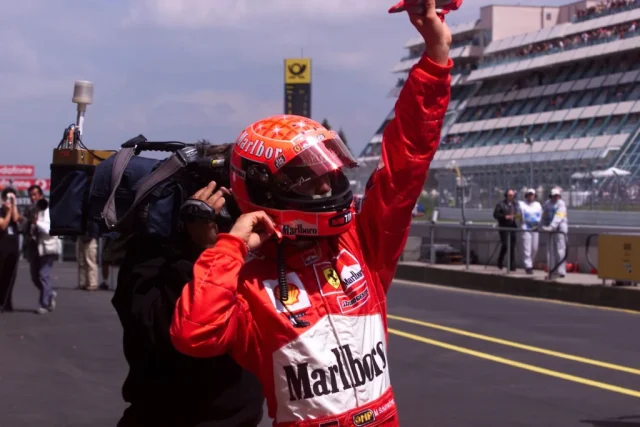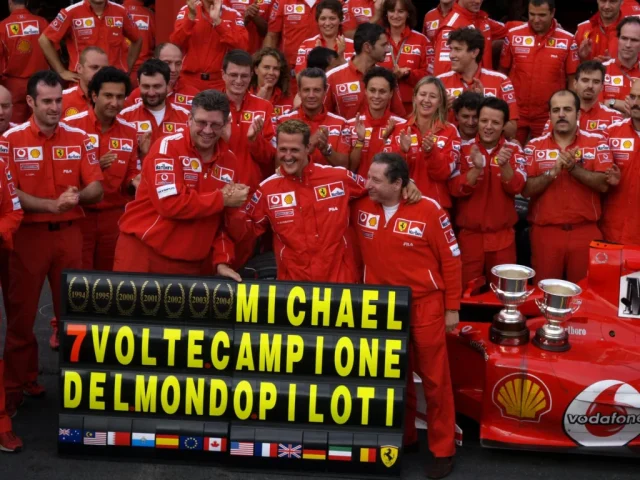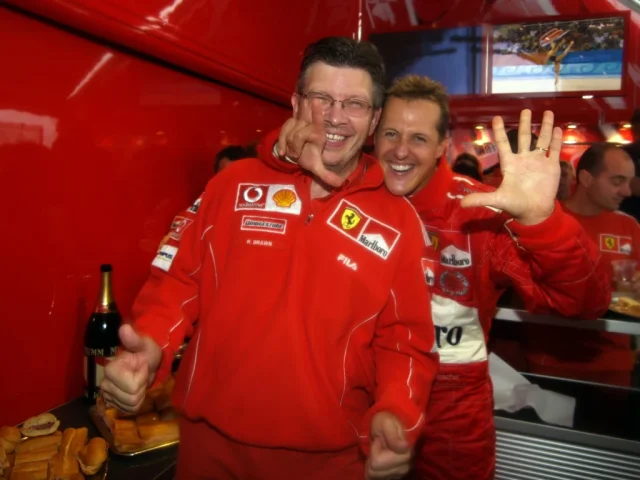When the world stepped into 1995, Michael Schumacher was on top of the racing world. At just 26 years old, the German had already claimed his first Formula 1 world title, defeating Damon Hill in a fierce 1994 season. Off the track, life looked just as promising—he was preparing to marry his longtime partner, Corinna Betsch.
But while fans expected another season-long duel between Hill and Schumacher, the year would ultimately be remembered for something far bigger. In August 1995, Schumacher made a career-defining decision that shocked the paddock, divided fans, and ultimately reshaped the future of Formula 1: he signed with Ferrari.
This is the story of how one of the sport’s most successful partnerships began—with plenty of drama, controversy, and heartbreak along the way.
Early Season Battles: Hill vs. Schumacher Round Two
The opening rounds of the 1995 championship were a continuation of the Schumacher-Hill rivalry. At Interlagos in Brazil, Schumacher struck first blood when Hill retired with suspension issues. Hill immediately responded, winning in Argentina and Imola, while Schumacher endured a costly crash at the Italian track.
But the Germans’ resilience shone through. At Barcelona, despite struggling with the Benetton B195, Schumacher returned to winning ways, stamping his authority once again.
Read more news: Latest mechanic news
The drama escalated in Monaco. After a multi-car crash brought out the red flag at the start, strategy became the deciding factor. Benetton outsmarted Williams, allowing Schumacher to leapfrog Hill and claim his second Monaco victory.
It was here, in the glamorous streets of Monte Carlo, that whispers shook the paddock: Schumacher might be heading to Ferrari.
The Rumour Mill Ignites
Ferrari, desperate to reclaim its former glory, saw a golden opportunity. Schumacher’s Benetton contract was running out, and the Italian team was ready to pay heavily for the reigning champion. With a new V10 engine designed to rival Renault’s dominant power units, Ferrari believed the time was right to secure Formula 1’s brightest star.
More photos and more info: check this one
Meanwhile, Jean Alesi—Ferrari’s fan-favorite driver—finally enjoyed his long-awaited moment in Montreal, taking his first career win after Schumacher’s gearbox failed. The victory only deepened the speculation: would Alesi soon be pushed aside to make room for Schumacher?
A Summer of Surprises
The middle of the season saw the rivalry intensify. At Silverstone, Schumacher and Hill collided, gifting victory to Johnny Herbert, while in Hockenheim, Hill was booed by German fans before crashing out, handing Schumacher a comfortable home victory.
Yet even as Schumacher built momentum, rumours of his Ferrari move dominated headlines. Initially, Schumacher denied the speculation. But by the summer break, insiders were certain—change was coming.
On August 16, 1995, the news broke: Michael Schumacher had signed for Ferrari until 1997. The “worst-kept secret in F1” was now official.
Shockwaves Across the Paddock
For Benetton, Schumacher’s departure was devastating. Team boss Flavio Briatore tried to reassure staff, claiming the team could cope without him. But deep down, everyone knew Schumacher was irreplaceable.
Meanwhile, Italian TV channels flooded the beaches, asking fans whether they preferred Schumacher or Alesi, producing almost comical scenes of sunbathers passionately debating Ferrari’s future.
Back on track, Schumacher was relentless. At Spa, he delivered one of his greatest ever drives—charging from 16th on the grid to victory. His aggressive defensive moves against Hill left the Briton furious, but it also proved Schumacher’s unmatched racecraft.
At Monza, however, Ferrari fans—the Tifosi—made their feelings clear. They booed Schumacher throughout the weekend, even unveiling a giant banner reading: “Better an Alesi today than 100 Schumachers tomorrow.”
Closing Out a Championship and a Chapter
Despite the controversy, Schumacher pressed on. Wins at the Nürburgring and TI Aida sealed his second consecutive world title, while Benetton also secured the Constructors’ Championship.
It was the perfect farewell gift before Schumacher turned the page to Ferrari. Alesi and Gerhard Berger were confirmed as Benetton’s 1996 line-up, while Ferrari surprised many by pairing Schumacher with the fiery Eddie Irvine.
By winter, Schumacher was already immersed in testing. At Estoril, he ran Ferrari’s V10 and even praised the older 412T2 chassis, suggesting he could have fought for titles in it. Then, at Fiorano, thousands of Tifosi turned up just to watch him complete test laps in red for the first time.
The Ferrari Years Begin
In 1996, Schumacher warned fans not to expect miracles. Ferrari was still unreliable, but his brilliance shone through. His wet-weather masterclass in Barcelona—where he dominated in torrential rain—was one of the greatest drives ever seen in Formula 1. Even sweeter was his victory at Monza, ending Ferrari’s eight-year wait for a home win and finally winning over the Tifosi.
Jean Todt, Ferrari’s team boss, gave Schumacher free rein to assemble his dream crew. Soon, Ross Brawn and Rory Byrne—both key figures in Benetton’s success—followed him to Maranello. Ferrari was no longer just a team; it was Schumacher’s project.
By 1997, Schumacher was fighting for titles again, though his infamous collision with Jacques Villeneuve at Jerez tarnished his reputation. Still, the foundations were in place. After near misses in 1998 and 1999 (the latter ending in a broken leg at Silverstone), the breakthrough finally came in 2000.
At Suzuka, Schumacher clinched Ferrari’s first Drivers’ Championship since 1979. What followed was pure domination: five consecutive titles from 2000 to 2004, cementing Schumacher and Ferrari as one of the greatest partnerships in sporting history.
Meanwhile at Benetton
The story at Benetton could not have been more different. Without Schumacher, the team slid backwards. The 1996 season was a disaster, with neither Alesi nor Berger able to win a race. By 1997, Briatore was gone, and the decline continued until Renault bought the team in 2000.
Ironically, Renault’s revival would come with another superstar: Fernando Alonso. By 2005, Alonso dethroned Schumacher, beginning a new era.
A Gamble That Redefined F1
Looking back, August 1995 stands as one of the most pivotal moments in Formula 1 history. Schumacher’s decision to gamble on Ferrari didn’t just change his career—it transformed the sport.
Benetton, once a powerhouse, never recovered. Ferrari, on the other hand, enjoyed an era of unprecedented glory, setting records that still define greatness today.
For Schumacher, the move was risky but proved to be the masterstroke of his career. He not only became Ferrari’s most successful driver but also raised the bar for what it meant to lead a team. To this day, every world champion who joins Ferrari is inevitably compared to him.
And while Ferrari has struggled to recapture those heights since, Schumacher’s legacy in red remains untouchable—a testament to how one bold decision reshaped Formula 1 forever.
FAQs
Why did Schumacher join Ferrari?
What did Ferrari gain from him?
His arrival marked a turning point: Ferrari went from being mired in politics and no recent titles to rebuilding a winning team. He helped bring the team back to a golden era.
When did Schumacher’s Ferrari deal happen?
The contract was confirmed during the 1995 season, officially announced in August. Rumors began at the Canadian GP before the move became public.
Who convinced him to pick Ferrari?
Ex-F1 driver Jochen Mass suggested Ferrari was better than Williams and played a role in guiding Schumacher toward the Prancing Horse.











Leave a Reply